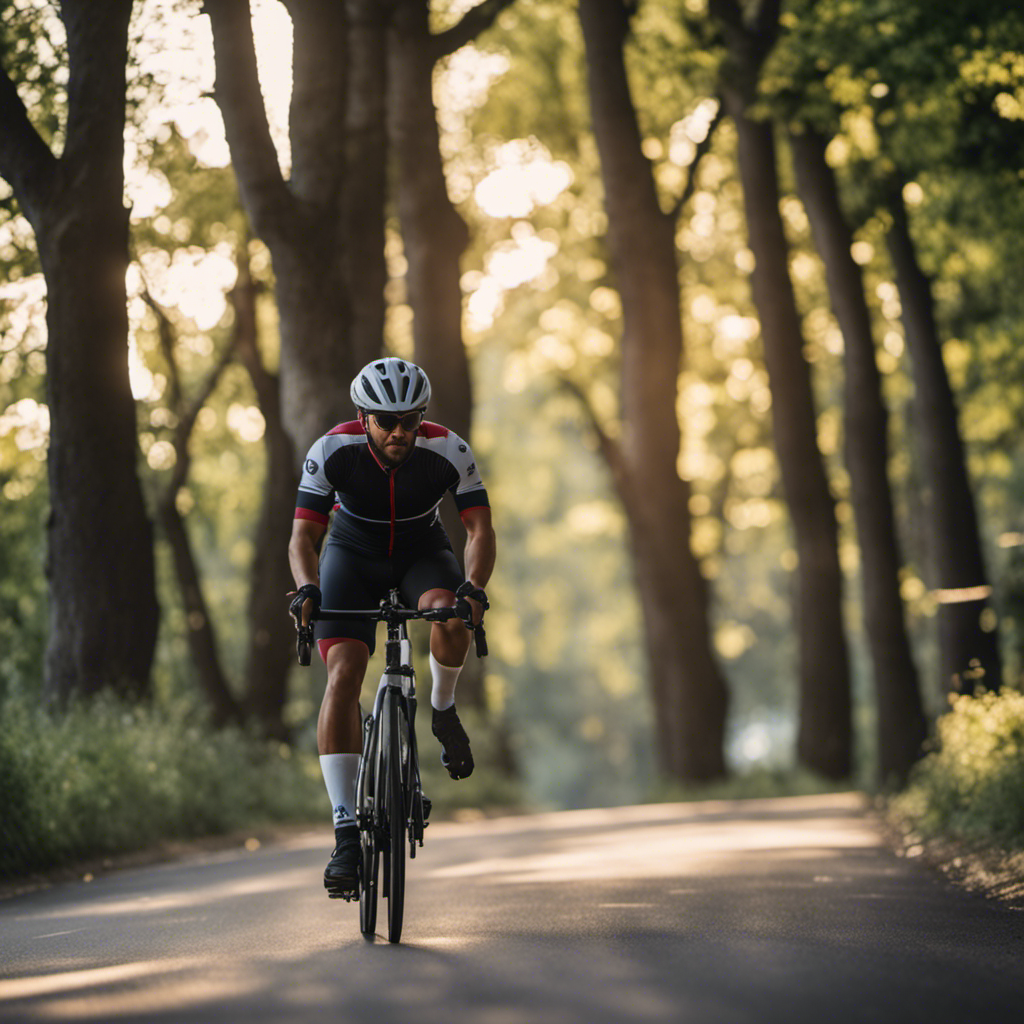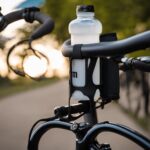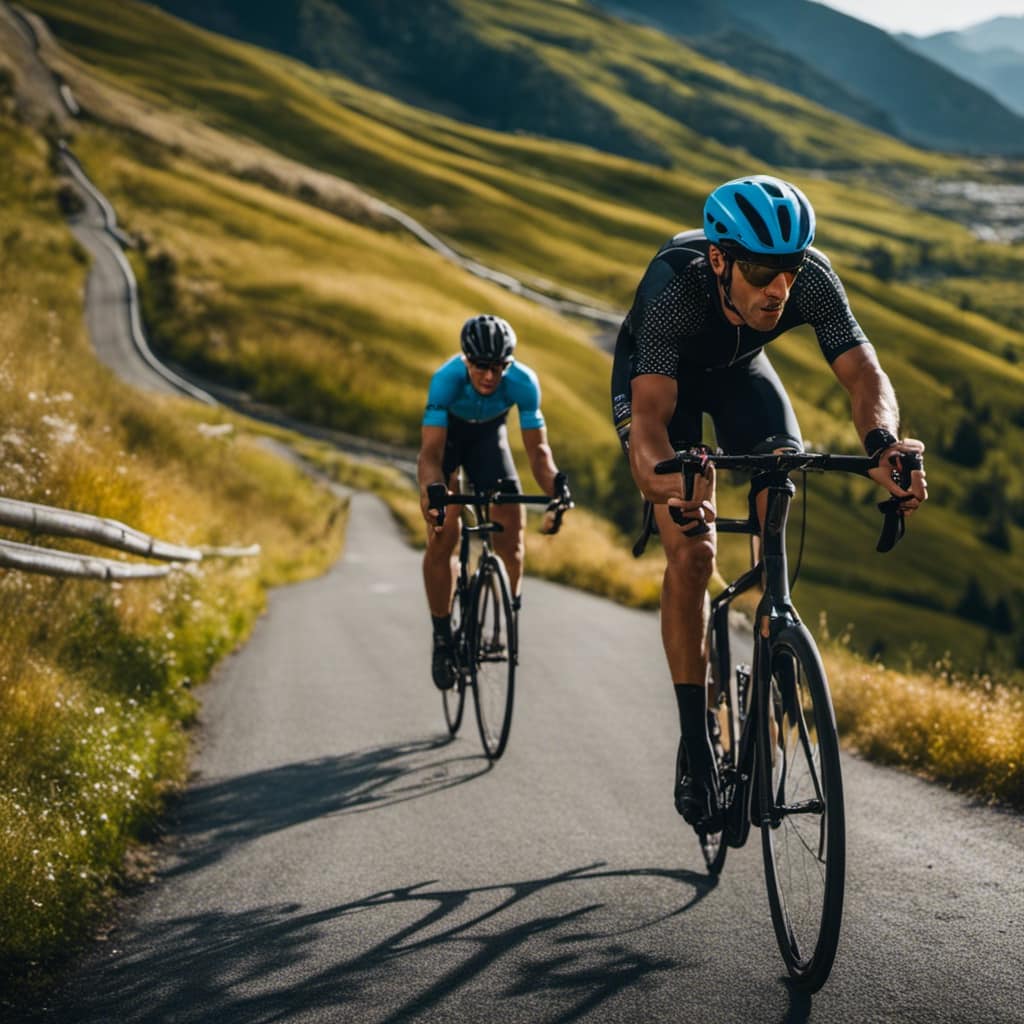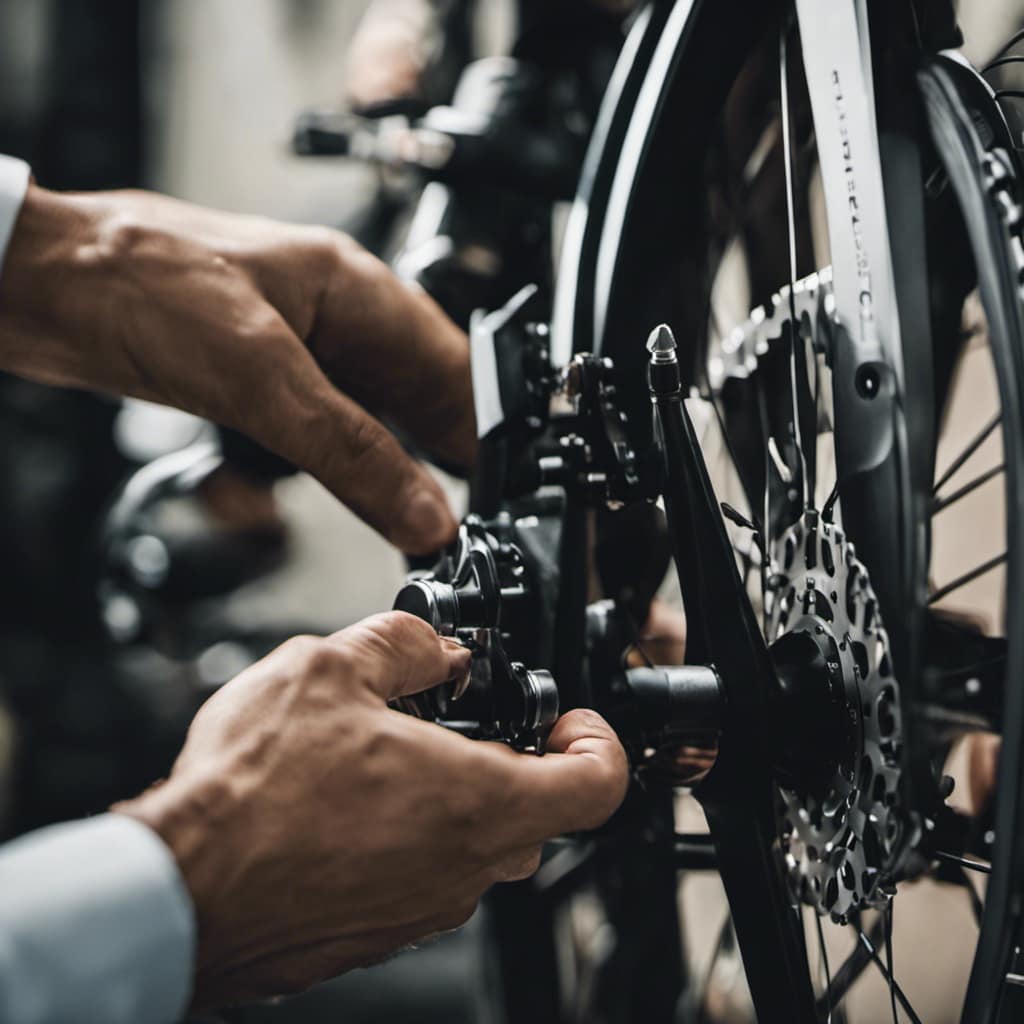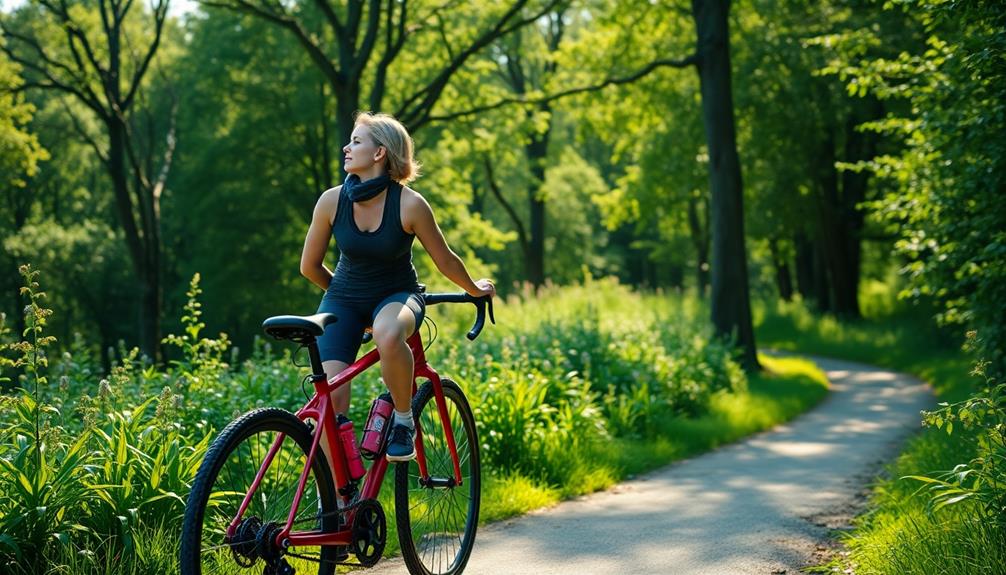We know you’re itching to hit the road on your hybrid bike, but before you do, let us enlighten you about the 12 essential components you absolutely need to know about.
These bad boys are the key to unlocking a whole new level of biking freedom.
From the frame material to the chain and cassette, we’ve got the lowdown on everything you need to ride with confidence and conquer any terrain.
Get ready to experience the exhilaration of true liberation on your hybrid bike.
Key Takeaways
- The frame and handlebars are crucial components of a hybrid bike, with different materials and handlebar options offering varying levels of performance, comfort, and control.
- There are two main types of brakes to choose from: disc brakes and rim brakes, each with their own advantages and considerations based on riding conditions and personal preferences.
- Brake pad materials also play a role in braking performance, with different options offering varying levels of stopping power, durability, and performance in different weather conditions.
- Gears and shifters are essential for a smooth and efficient riding experience, with gear ratios determining ease of pedaling and speed control, and regular maintenance and inspection required for optimal performance.
Frame Material
First, let’s talk about the different frame materials used in hybrid bikes. The frame material plays a crucial role in determining the overall performance and comfort of the bike.
Hybrid bikes generally come in three main frame materials: aluminum, carbon fiber, and steel. Aluminum frames are lightweight, durable, and offer a responsive ride. Carbon fiber frames, on the other hand, are incredibly lightweight and provide excellent shock absorption, making them ideal for riders seeking a smoother and more comfortable ride. Steel frames are known for their strength and durability, making them suitable for riders seeking a more robust and resilient bike.
Additionally, when it comes to handlebar grips, hybrid bikes usually offer a variety of options to choose from, such as foam, rubber, or gel grips. These grips offer different levels of comfort and grip, allowing riders to find the perfect fit for their hands.
With the right frame material and handlebar grips, your hybrid bike can provide the liberating experience you desire.
Now, let’s move on to the next section and discuss the crucial component of brakes.
Brakes
When it comes to brakes on hybrid bikes, there are a few key points to consider.
First, the choice between disc brakes and rim brakes is crucial, as each has its own advantages and disadvantages.
Secondly, you’ll need to decide between hydraulic brakes and mechanical brakes, with hydraulic brakes offering more precise and powerful stopping power.
Lastly, the type of brake pad material you choose can greatly impact your braking performance and durability.
Disc Vs. Rim Brakes
Let’s dive into the discussion of disc brakes versus rim brakes and understand the key differences between them. When it comes to choosing brakes for your hybrid bike, it’s important to consider the advantages and disadvantages of both options. Here are three important factors to consider:
-
Stopping Power: Disc brakes offer superior stopping power compared to rim brakes. With their hydraulic or mechanical system, disc brakes apply force directly to a rotor, providing consistent and reliable stopping performance in all weather conditions.
-
Maintenance: Rim brakes are generally easier to maintain as they’re simpler in design and don’t require frequent adjustments. On the other hand, disc brakes may require periodic maintenance, such as rotor alignment and pad replacement.
-
Riding Conditions: If you frequently ride in wet or muddy conditions, disc brakes are a better choice as they’re less affected by water and mud compared to rim brakes. However, if you primarily ride on dry roads, rim brakes can provide sufficient stopping power.
Ultimately, the choice between disc brakes and rim brakes depends on your riding style and the conditions you ride in. Consider your needs and preferences to make an informed decision and enjoy a liberating biking experience.
Hydraulic Vs. Mechanical Brakes
We should consider the differences between hydraulic and mechanical brakes when discussing the subtopic of ‘Hydraulic Vs. Mechanical Brakes (Brakes)’.
When it comes to choosing the right brakes for your hybrid bike, understanding the advantages of hydraulic brakes can be crucial. Hydraulic brakes use fluid to transmit force, resulting in a more efficient and powerful braking system. These brakes provide better modulation, allowing for precise control and smoother braking. They also require less effort to engage and provide consistent stopping power, regardless of weather conditions. Additionally, hydraulic brakes are self-adjusting, meaning they automatically compensate for pad wear, ensuring optimal performance at all times.
Brake Pad Materials
Our knowledge about the different brake pad materials is crucial in understanding how they affect the braking performance of our hybrid bikes. The brake pads are an essential component of our bike’s braking system, and choosing the right material can greatly impact our overall riding experience.
Here are three brake pad materials that every cyclist should know about:
-
Organic Brake Pads: These pads are made from a blend of organic materials like rubber, resin, and kevlar. They offer excellent stopping power and are quieter compared to other materials. However, they tend to wear out faster and may not perform as well in wet conditions.
-
Semi-Metallic Brake Pads: These pads are made from a mixture of metal and organic materials. They provide a good balance between stopping power, durability, and noise levels. They’re suitable for various riding conditions and offer better performance in wet weather compared to organic pads.
-
Sintered Brake Pads: These pads are made from a combination of metallic particles and binders. They offer exceptional stopping power, excellent heat dissipation, and durability. They’re ideal for riders who frequently ride in extreme conditions or engage in heavy braking. However, they may produce more noise and can wear down the brake rotors faster.
When it comes to choosing the right brake pad material, it’s essential to consider our riding style, terrain, and weather conditions. Upgrading our brake pad materials can significantly improve our bike’s braking performance, ensuring a safer and more enjoyable riding experience.
In addition to brake pad materials, another important aspect of our hybrid bikes’ braking system is handlebar accessories. These accessories, such as brake levers and brake cables, play a crucial role in activating the brakes and controlling our bike’s speed. Ensuring that our handlebar accessories are in good condition and properly adjusted is vital for responsive and reliable braking. Regular maintenance and inspection of these components will help us maintain optimal braking performance and enhance our overall riding experience.
Gears and Shifters
When it comes to hybrid bike components, gears and shifters play a crucial role in providing a smooth and efficient riding experience. Understanding the importance of gear ratio is essential, as it determines the ease of pedaling and speed control.
Additionally, knowing the different types of shifters available, such as trigger shifters or twist shifters, allows riders to choose the one that best suits their preferences and riding style.
Gear Ratio Importance
Gear ratios play a crucial role in determining the performance and efficiency of our hybrid bikes. When it comes to gear ratio optimization, understanding its impact on performance is key. Here are three reasons why gear ratios are so important:
-
Effortless Climbing: The right gear ratio allows us to conquer steep inclines with ease, making uphill rides a breeze.
-
Speed and Power: A well-balanced gear ratio enables us to maintain high speeds on flat surfaces while also providing the power needed for quick acceleration.
-
Energy Conservation: By choosing the right gear ratio, we can maximize our pedaling efficiency, conserving energy and reducing fatigue during long rides.
With gear ratios playing such a vital role in our biking experience, it’s essential to have a thorough understanding of how they affect our performance. Now, let’s delve into the different types of shifters and how they can further enhance our riding experience.
Shifter Types Explained
Exploring the different types of shifters and understanding their functions is crucial for improving our overall biking experience.
When it comes to shifting gears on a hybrid bike, there are various mechanisms to choose from. The most common types of shifters include trigger shifters, twist shifters, and thumb shifters. Trigger shifters are located on the handlebars and can be easily operated with the index finger.
Twist shifters, on the other hand, involve rotating a grip on the handlebars to shift gears. Thumb shifters are also handlebar-mounted and require the use of the thumb to shift gears. Each of these shifter mechanisms has its own advantages and can be preferred based on personal preference and riding style.
However, one type of shifter that has gained popularity in recent years is the electronic shifter. These shifters use electronic signals to shift gears, providing precise and smooth shifting without the need for mechanical cables. The advantages of electronic shifters include faster shifting, lighter weight, and the ability to shift under load.
They also require less maintenance compared to traditional mechanical shifters. Ultimately, the choice of shifter mechanism depends on individual preference and riding style, but it’s important to explore the different options available to enhance our biking experience.
Suspension Fork
Our favorite feature of the suspension fork is its ability to absorb impact and provide a smoother ride on rough terrains. It’s like having your own personal shock absorber, allowing you to tackle bumpy roads and trails with ease.
Here are three things you should know about suspension forks:
-
Pros and Cons of Suspension Forks: Suspension forks offer numerous benefits, such as improved comfort, better control, and increased traction. However, they also add weight to your bike and can be more expensive to maintain compared to rigid forks. It’s important to weigh these factors and consider your riding style before deciding if a suspension fork is right for you.
-
How to Choose the Right Suspension Fork for Your Hybrid Bike: When selecting a suspension fork, consider factors like travel length, wheel size compatibility, and adjustability options. Determine the type of terrain you’ll be riding on and choose a fork that suits your needs. Additionally, ensure that the fork is compatible with your bike’s frame and other components for optimal performance.
-
Seek liberation with a suspension fork: With a suspension fork, you can say goodbye to the discomfort and jarring impacts of rough terrains. It opens up a whole new world of possibilities, allowing you to explore off-road trails and enjoy a smoother ride. Embrace the freedom and choose a suspension fork that enhances your riding experience.
Handlebars
When it comes to handlebars, there are a few key points that every cyclist should know.
Firstly, there are different types of handlebars, such as flat, riser, drop, and bullhorns, each offering unique benefits and riding positions.
Secondly, choosing the right handlebars is crucial for comfort and control, considering factors like riding style, body position, and personal preference.
Lastly, handlebar accessories and grips can greatly enhance the riding experience, providing added comfort, grip, and versatility.
Types of Handlebars
Let’s dive into the different types of handlebars commonly used in hybrid bikes.
Handlebars are an essential component of any bike, as they provide control and comfort during rides. When choosing handlebar accessories, it’s crucial to understand the advantages of different handlebar types.
Here are three types of handlebars to consider:
-
Flat Handlebars: These handlebars are straight and provide a more upright riding position. They’re ideal for riders who prefer a relaxed and comfortable riding experience. Flat handlebars also offer better control and visibility in urban environments.
-
Drop Handlebars: Drop handlebars are commonly found on road bikes. They’ve a curved shape that allows for multiple hand positions and aerodynamic riding. These handlebars are perfect for riders who prioritize speed and efficiency.
-
Riser Handlebars: Riser handlebars have a slight upward bend, providing a more upright riding position than drop handlebars. They’re suitable for riders who want a balance between comfort and control on varied terrains.
Understanding the advantages of different handlebar types will help you choose the right one for your hybrid bike. So, go ahead and explore the world of handlebars to enhance your cycling experience.
Choosing the Right Handlebars
We’ll explore the different factors to consider when selecting handlebars for your hybrid bike. The handlebars are a crucial component of your bike, as they provide stability, control, and comfort while riding. When choosing handlebars, you should consider the different handlebar shapes and handlebar width options available.
Handlebar shapes come in various styles, each offering unique benefits. Some common handlebar shapes include flat bars, drop bars, and riser bars. Flat bars are straight across and provide a more upright riding position, ideal for casual rides or commuting. Drop bars are curved and offer multiple hand positions, suitable for longer rides or racing. Riser bars have a slight upward sweep, providing a more comfortable position for off-road riding.
In terms of handlebar width, it’s essential to choose a width that matches your shoulder width for optimal comfort and control. A wider handlebar offers better stability, especially when navigating tricky terrain, while a narrower handlebar provides better aerodynamics.
By considering the different handlebar shapes and handlebar width options, you can select the one that best suits your riding style and preferences.
Now let’s move on to the next section, where we’ll discuss handlebar accessories and grips.
Handlebar Accessories and Grips
Occasionally, handlebar accessories and grips can enhance the comfort and functionality of your hybrid bike. These small additions can make a big difference in your riding experience.
Here are three handlebar accessories and grips that you should consider for your hybrid bike:
-
Handlebar Grips: Comfortable handlebar grips are essential for a smooth and enjoyable ride. Look for grips that offer cushioning and support to reduce hand fatigue and absorb vibrations.
-
Phone Mount: A phone mount allows you to securely attach your smartphone to your handlebars, making it easy to access navigation, track your ride, or listen to music while cycling.
-
Handlebar Bag: A handlebar bag is a convenient accessory for storing your essentials during your ride. It provides easy access to items like your phone, keys, wallet, or snacks, without the need for a backpack or saddlebag.
Investing in high-quality handlebar grips and accessories can greatly enhance your riding experience, providing comfort, convenience, and liberation on your hybrid bike.
Wheels and Tires
When choosing a hybrid bike, we recommend considering the durability and traction of the wheels and tires. The right wheels and tires can greatly enhance your riding experience, providing a smooth and stable ride on various terrains. One important aspect to consider is whether to opt for tubeless tires. These tires eliminate the need for inner tubes, reducing the risk of flats and providing a more comfortable ride. Additionally, you should also look into the tire width options. Wider tires offer better stability and grip, especially on uneven surfaces, while narrower tires are more suitable for faster rides on paved roads. Here is a table showcasing different tire width options and their recommended uses:
| Tire Width | Recommended Use |
|---|---|
| 32mm | Commuting and light off-road trails |
| 38mm | Versatile for both road and off-road riding |
| 42mm | Ideal for rough terrains and gravel roads |
| 50mm | Maximum traction for mountain biking |
Considering these factors will ensure that you choose the right wheels and tires for your hybrid bike, allowing you to tackle any adventure that comes your way. Now, let’s move on to the next section about the ‘crankset and bottom bracket’.
Crankset and Bottom Bracket
As avid cyclists, we understand the importance of selecting the right crankset and bottom bracket for optimal performance on our hybrid bikes. These two components play a crucial role in transferring power from our legs to the wheels, allowing us to achieve maximum efficiency and speed.
When it comes to crankset maintenance, regular cleaning and lubrication are essential to ensure smooth operation and prevent wear and tear.
As for bottom bracket types, there are three main options to consider:
-
Threaded Bottom Bracket: This traditional type is easy to install and service, making it a popular choice among riders.
-
Press-Fit Bottom Bracket: Designed for increased stiffness and reduced weight, this type offers a wider range of frame compatibility.
-
Integrated Bottom Bracket: This lightweight option integrates the bottom bracket bearings directly into the frame for improved power transfer and durability.
Pedals
One of the most important components of our hybrid bikes are the pedals, as they provide the connection between our feet and the bike, allowing us to generate power and control our movements. When it comes to choosing pedals for our hybrid bikes, we have two main options: clipless pedals and platform pedals.
Clipless pedals are popular among experienced riders who desire liberation from traditional toe clips. These pedals use a cleat system that attaches to special cycling shoes, providing a secure and efficient transfer of power from our legs to the bike. They also allow for easy engagement and disengagement, making them ideal for stop-and-go city riding or off-road adventures.
On the other hand, platform pedals offer simplicity and versatility. These pedals have a flat surface that accommodates any type of footwear, making them perfect for casual rides or commuting. They provide a solid grip and allow for quick and easy foot placement, giving us the freedom to ride in any shoes we desire.
Here is a comparison of clipless pedals and platform pedals:
| Clipless pedals | Platform pedals |
|---|---|
| Attach to special cycling shoes | Accommodate any type of footwear |
| Provide secure power transfer | Offer simplicity and versatility |
| Easy engagement and disengagement | Solid grip and quick foot placement |
Whether we choose clipless or platform pedals for our hybrid bikes, it’s important to consider our riding style, preferences, and goals. Both options offer unique benefits, allowing us to enjoy the freedom and liberation that comes with riding a hybrid bike.
Saddle
We need to carefully choose the saddle for our hybrid bikes, as it plays a crucial role in our comfort and overall riding experience.
When it comes to saddle height, it’s important to find the right balance. A saddle that’s too high can cause discomfort and put unnecessary strain on our knees, while a saddle that’s too low can lead to inefficient pedaling and discomfort in the hips. Finding the perfect saddle height will ensure a smooth and enjoyable ride.
Additionally, saddle comfort is key. Look for a saddle with adequate padding and support, as well as a design that suits our body shape.
Stem and Headset
When it comes to the stem and headset of our hybrid bikes, it’s important to understand their role in ensuring proper handling and control while riding. The stem connects the handlebars to the fork steerer tube, while the headset allows for smooth steering and stability.
These components play a crucial role in maintaining the overall balance and maneuverability of the bike. When choosing a stem and headset, factors such as frame material, brake type (disc vs. rim brakes), and gear system should be considered. Additionally, understanding the difference between hydraulic and mechanical brakes, as well as the various brake pad materials, is essential for optimal stopping power.
Gears and shifters, along with gear ratio importance, should also be taken into account. The right handlebars, whether flat, riser, or drop, can greatly impact comfort and control. Consider handlebar accessories and grips to further enhance the riding experience.
Wheels and tires, crankset and bottom bracket, pedals, saddle, derailleurs, chain and cassette, and handlebar height adjustment all contribute to the overall performance and comfort of the bike. Lastly, proper headset maintenance is necessary for smooth and safe riding.
Derailleurs
To ensure smooth gear shifting and optimal performance, it’s important to understand and properly maintain the derailleurs on our hybrid bikes. Derailleurs are an essential component that allows us to change gears and adapt to different terrains. Here are three key things to know about derailleurs:
-
Types of Derailleurs: There are two main types of derailleurs – front and rear. The front derailleur controls the movement of the chain between the chainrings, while the rear derailleur shifts the chain across the cassette. Understanding their functions and how they work in tandem is crucial for efficient gear shifting.
-
Proper Adjustment: A well-adjusted derailleur ensures precise and smooth gear changes. It’s essential to learn how to adjust the limit screws and cable tension correctly. Regular maintenance and fine-tuning will ensure optimal performance.
-
Handlebar Position: The position of the gear shifters on the handlebars can greatly affect our riding experience. Experimenting with different positions and finding the most comfortable and intuitive setup can enhance our control and enjoyment while riding.
Chain and Cassette
With proper maintenance and regular cleaning, the chain and cassette on our hybrid bikes can provide smooth and reliable gear shifting. The chain is an essential component that transfers the power from our legs to the rear wheel. To ensure its longevity and optimal performance, regular chain maintenance is crucial. This includes cleaning, lubricating, and checking for any signs of wear or damage. Additionally, understanding cassette ratios can greatly enhance our riding experience. The cassette is a set of gears located on the rear wheel hub, and it determines the range of gearing options available to us. By selecting the appropriate cassette ratios, we can customize our gear shifting to match our riding style and terrain, providing us with the freedom and liberation to conquer any road or trail.
| Component | Description |
|---|---|
| Chain | Transfers power from legs to rear wheel |
| Cassette | Set of gears located on the rear wheel hub |
| Maintenance | Regular cleaning, lubricating, and checking for wear |
| Cassette Ratios | Determine range of gearing options |
| Personalization | Customize gear shifting to match riding style and terrain |
Conclusion
In conclusion, when it comes to hybrid bike components, every little detail matters. Just like the gears seamlessly shift and the brakes smoothly stop, each element of the bike works together harmoniously to provide the ultimate riding experience.
Just as a conductor leads an orchestra, these components play their own unique role, creating a symphony of performance and passion.
So, whether you’re a casual rider or a devoted cyclist, understanding and appreciating these essential components will elevate your biking journey to new heights.

